Editor & Publisher has a 3,000-word special report on the newspaper industry’s prospects that doesn’t turn up much new ground but documents the panic that has set in across the business. Everything is on the table, industry execs now say. In the coming year, expect a lot of papers to eliminate money-losing Monday, Tuesday and Saturday editions, dump their classified advertising sections and combine forces with rivals or outsource overseas. Recent redesigns like those at the South Florida Sun-Sentinel are intended to be produced by smaller staffs. Some papers consider giving up on courting the youth audience and decide to just focus on giving their older readers something they’ll want to consume for the next 25 years.
The problem is that newspaper are tinkerers, not re-inventers, the piece concludes. Their core skills are mis-matched to the enormity of the task that faces them, and the unrelenting declines in business have left them with no option to think through bigger changes. Noting the waning interest in the the “Newspaper Next” program, the American Press Institute’s Drew Davis quotes one board member as saying, “We are like drowning people, who are treading water as fast as we can. And you people are throwing life preservers and we can’t even get our hands out of the water to reach them.”
In its first year, Newspaper Next reached some 6,000 people, but since API rolled out its 2.0 version last February, the response has not been anywhere near that, says Davis. The biggest newspaper companies, he adds, are most conspicuous in their absence.
Not everyone is as dour as the people quoted by E&P. Kevin Slimp reports on a recent meeting by a group of consultants, speakers and trainers who call themselves the Media Specialists Group. They discussed the future of newspapers and, while they agree that big dailies are mostly toast, they’re generally optimistic about circulation trends among regional and focused titles. Expect to see a lot more free distribution and segmentation, they say. Newspaper publishers will also do more contract printing and use their delivery channels to distribute advertising.
Decline is Worse Than Numbers Indicate
Vin Crosbie submits the most lucid, dispassionate and coherent explanation for the decline of the US newspaper business that we’ve seen since Eric Alterman’s groundbreaking piece in The New Yorker this spring. The industry’s problem isn’t the Internet, he argues, it’s the steady loss of respect for and contact with its readers, a trend that began more than 30 years ago. While absolute circulation has declined only 14.5% since 1970, the real decline is more like 45% when adjusted for population growth. Only a third of Americans say they read a newspaper yesterday and only 46% read one regularly, down from 71% in 1992.
Crosbie skillfully skewers the online readership data that newspaper execs use to obscure their problems, pointing out that readers who visit four or five times a month can’t be compared to subscribers. He also dismisses the so-called “passalong rate,” which dying publications like to use to inflate circulation numbers
In the end, he predicts that half of all American dailies will be gone – both online and in print – by the end of the next decade. He promises more analysis of what went wrong in essays today and next week.
In his analysis, Crosbie also ticks off the precipitous decline in newspaper share values over the least few years, ranging from 65% at Gannett to 99% at Journal Register, yet
Morningstar believes the companies are still overvalued. In a report subtitled “The newspaper business is in terminal decline,” Matthew Coffina analyzes the outlook for Gannett, The New York Times Co., Lee Enterprises, McClatchy and GateHouse Media and sees, at best, relatively fast ongoing deterioration of their businesses. “[We] consider the newspaper industry unattractive as a whole,” he writes.
Is Yahoo Friend or Foe?
First, Yahoo created an ad consortium and invited newspapers in so they could sip from the cup of online spending. Now it’s competing with its partners. In an Agence France Presse story (carried, ironically, on Yahoo News), Glenn Chapman reports that Yahoo is here to stay as a primary news source. It’s got feet on the street in Beijing for the Olympics (following the herd there) and has scored coups with recent interviews with South Korean president Lee Myung-bak and George W. Bush, who gave his first Internet-only interview to Yahoo. One of its tactics is apparently to ask readers to submit questions during interviews with dignitaries, which is kind of cool, when you think about it. (via Josh Catone).
For some reason, the industry’s troubles are hitting particularly hard in New Jersey. Newsday gathers up the bad news: Gannett just 120 jobs in six Jersey papers. The owner of the Newark Star-Ledger says the paper is on track to lose $30 million to $40 million this year. And the Hackensack Record just sold its building and will turn most of its staff reporters into “mobile journalists,” which is a new euphemism for “stringer.”
Novel Concept
Jason Mandell writes about a writer’s novel approach to sustaining investigative journalism using a community support model. David Cohn, a former tech and science reporter for Wired, has created Spot.Us, a place where journalists can float ideas for investigative reporting pieces and get funded by visitors, who vote with their wallets for the stories they like. The results are then syndicated to partner outlets. “If you get 100 people to give just $15, that’s enough to pay a journalist to do a story on something that will benefit the community,” Cohn told Mandell. Spot.US is partially funded, ironically, by Knight Foundation. Knight-Ridder was forced to sell out to McClatchy two years ago and has suffered along with its acquirer. Maybe Spot.Us is a way to begin to build at least a shell of a new vision for investigative journalism.
Layoff Log
How bad is morale at USA Today? The Gannett Blog floats the possibility that the national daily, which has so far escaped outright layoffs, may finally be on the chopping block. What’s most interesting, though, is the 50+ comments, most of them from people purporting to be USA Today employees, describing the dour mood in the halls and speculating about a big meeting next week with the publisher. There’s also an interesting account of a recent internal meeting at which tensions flared between print and online staff. Apparently, online is now the favored child at McPaper and some of the print veterans resent it.
Also,
And Finally…
Slate’s Jack Shafer Ron Rosenbaum hates pencil puzzles, and his rant against a practice that he sees growing in popularity is worth reading just for gems like his characterization of Sudoku as the “mind-numbing hillbilly heroin of the white-collar class.” Shafer Rosenbaum picks up copies of Will Shortz’s Funniest Crossword Puzzles and let’s the first “down” clues speak for themselves:
4. Highly ornamented style
5. Tell ___ glance
Whoa, dude, you’re killin’ me!
Puzzle addicts could cure cancer if they’d apply their brains more appropriately, like by reading a book, he says. “For you puzzle people: Reading is a seven-letter word for what you’re depriving yourself of every sad minute you’re spending on your empty boxes.” In the end, “there are two kinds of brains. Those hardwired to obtain deep pleasure from arranging letters in boxes and those hardwired to get the creeps from the process.”
It’s very funny. Now, back to our puzzle…
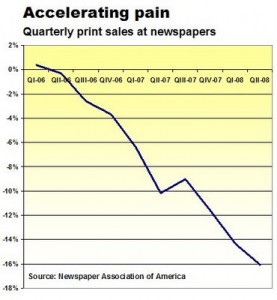 The chart (from Alan Mutter) says it all. The U.S. newspaper industry experienced its ninth consecutive quarter of falling print revenue, according to the Newspaper Association of America. Worse is that the rate of decline is accelerating and online revenue is now dropping, too. Although the second quarter decline was only 2.4%, it’s a stark contrast to the 20%+ growth rates the rest of the industry is experiencing.
The chart (from Alan Mutter) says it all. The U.S. newspaper industry experienced its ninth consecutive quarter of falling print revenue, according to the Newspaper Association of America. Worse is that the rate of decline is accelerating and online revenue is now dropping, too. Although the second quarter decline was only 2.4%, it’s a stark contrast to the 20%+ growth rates the rest of the industry is experiencing.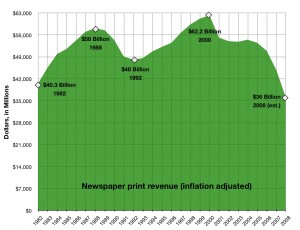

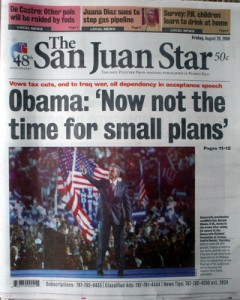
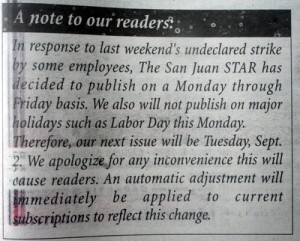
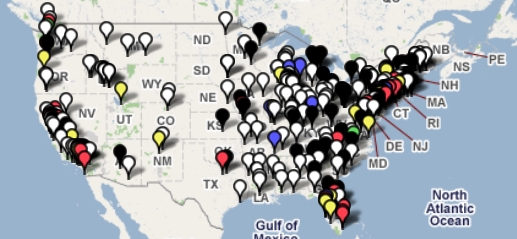
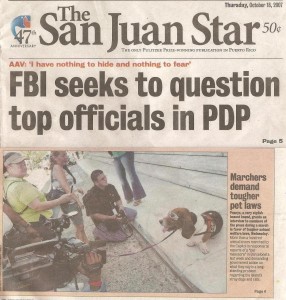


 If you’ve ever taken a “money shot,” you’ll appreciate
If you’ve ever taken a “money shot,” you’ll appreciate 

